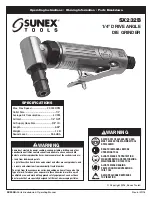
ENGLISH
21
INTENDED USE
Your concrete surface grinding shroud has been
designed for dust removal of the following: grinding,
leveling and polishing concrete surfaces. It can
remove dust when removing surface paint, epoxy
and glue. Using the appropriate grinder, diamond
grinding wheel and dust extractor vacuum it can
be used to remove the vast majority of static and
airborne dust which without the use of the surface
grinding shroud could otherwise contaminate the
working environment or pose an increased health
risk to the operator and those in close proximity. This
concrete surface grinder should ALWAYS be used
with a M class dust extractor designed for concrete
dust removal, like the D
E
WALT DWV902M.
DO NOT
use under wet conditions or in presence of
flammable liquids or gases.
The surface grinding shroud is a professional tool.
DO NOT
let children come into contact with the
tool. Supervision is required when inexperienced
operators use this tool.
• This product is not intended for use by persons
(including children) suffering from diminished
physical, sensory or mental abilities; lack of
experience, knowledge or skills unless they are
supervised by a person responsible for their
safety. Children should never be left alone with
this product.
ASSEMBLY AND ADJUSTMENTS
WARNING: To reduce the risk of
injury, ALWAYS turn off the tool
and disconnect the tool from
the power source before making
any adjustments or removing
or installing attachments or
accessories. This applies to both
the grinder and the dust extractor
vacuum.
Such preventative safety
measures reduce the risk of starting the
tool accidentally.
Mounting and Removing Surface
Grinding Shroud (fi g. 2–4)
NOTE:
The shroud and adaptor (g) have a tight fit
onto the grinder. Take extra care when mounting the
shroud.
1. Follow the mounting and removing guard
instructions in the power tool manual to remove
the existing guard from grinder.
2. If present, remove the stop screw (i) from your
D
E
WALT grinder with a T40 star wrench.
WARNING :
After removing the stop
screw the grinder cannot be used with
a type 1 guard or a type 27 guard for
grinding or cutting applications. To
perform these applications stop screw
MUST be put back in place. Performing
grinding and cut-off applications without
having the stop screw in place can
result into death or serious injury due to
malfunction of the guarding system.
3. With the beveled edge facing upward from the
shroud collar, insert the gear case adaptor (g)
partially into the collar, refer to figure 3.
4. Aligning the adaptor and shroud with the gear
casing, push them both down onto the gear
case with your thumbs. You can also use
a large flathead screwdriver to be sure the
adaptor is seated correctly. Both the shroud and
the adaptor should slide down onto the gear
case at the same time.
5. Position shroud to desired orientation, and
tighten hose clamp screw (a) securely.
6. To remove the shroud, repeat these steps in
reverse.
NOTICE:
If surface grinding shroud
cannot be tightened by the hose clamp
screw, do not use the tool and take the
tool and surface grinding shroud to a
service center to repair or replace the
surface grinding shroud.
Mounting Dry Diamond
Surface Cup Wheels (fi g. 5)
WARNING:
DO NOT use Type 1 cutting
wheels or bonded abrasive wheels.
Damage or personal injury could result.
Follow the mounting and using cutting wheels
instructions in the tool manual and mount the
grinding wheel.
Dry diamond surface cup wheels (j) are
recommended for use with this shroud.
Dust Extraction (fi g. 7–9)
WARNING:
Use only power tools
recommended by D
E
WALT with this
attachment. For technical specifications
refer to
Technical Data.
For more information about D
E
WALT power tools
compatible with this attachment, please contact one
of the authorised services centres listed on the back
cover or refer to the full details of our after-sales
service available on the Internet at:
www.2helpU.
com
.
Summary of Contents for DWE46170
Page 1: ...DWE46170 ...
Page 3: ...1 Figure 1 Figure 2 Figure 4 Figure 3 a b g g c d e h f i a ...
Page 4: ...2 Figure 5 Figure 7 Figure 8 Figure 6 f f k k l j d ...
Page 106: ......
Page 107: ......
















































